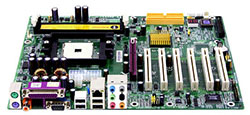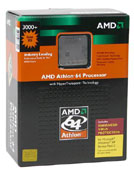Buyer's Guide - Entry Level to Mid-Range, March 2005
by Jarred Walton on March 15, 2005 1:30 PM EST- Posted in
- Guides
CPU and Motherboard: AMD
In the past Budget Guides, we have continued to list socket A options due to their lower cost. Features and performance may be more limited, and the platform as a whole is reaching the end of the road. It has been a long ride since the initial launch of socket A, and we're now removing it from our recommendations. If you can pick up the parts used or at clearance prices, though, it can still offer plenty of power. Our move to socket 754 began with the last Budget Guide, and recent additions to AMD's lineup now allow us to complete the transition.  |
 |
| Click images to enlarge. | |
Socket 754 Motherboard: EPoX EP-8KDA3J
Price: $74 shipped
Socket 754 CPU: AMD Sempron 2800+ 1.6 GHz 256KB L2
Price: $89 shipped (Retail)
Total: $163
We've waffled back and forth on the motherboard recommendation for socket 754, and both the EPoX that we list here as well as the Chaintech VNF-250 continue to be good value recommendations. The EPoX wins out on features, while the Chaintech wins out on RAM support and overclocking, as well as overall stability. When using two DIMMs on the EPoX, particularly lower quality (i.e. lower price) modules, you may be forced to run DDR333 speeds instead of DDR400. We would recommend purchasing better RAM for the best compatibility. Even at DDR333 speeds, however, performance is quite good. The remaining features - including hardware firewall, gigabit Ethernet, and Firewire support - all put the EPoX board ahead of other similarly-priced boards.
If you don't need those features, then other boards can be had for less money. We prefer to increase performance and reliability by using the nForce3 250 chipsets on socket 754, but some people will be interested more in cutting costs. Motherboards using SiS, ALi, and VIA can be found at lower prices, and some of them will include integrated graphics that will help to reduce the total system price (and performance) even further. If you're willing to make the trade-off in performance for money, the Chaintech MK8M800 is a micro-ATX board with integrated graphics that costs $65. Memory capacity is limited to two DIMMs totaling 2GB, and overclocking is definitely not a priority. For $65, though, you can get a decent start on a system that will handle most business/office computing tasks for many years (providing nothing malfunctions).
Our CPU recommendation this time goes to the newly launched Sempron 2800+ 90nm processor. Heat and power use should be very low, thanks to the smaller process technology. Overclocking should also be good if you're interested in that, but with an 8X multiplier, you will very likely be limited to 2.2GHz, give or take. Otherwise, performance will be very similar to that of the Sempron 3100+, only ~10% slower due to the lower CPU speed. At $90, socket 754 is now truly in the realm of the budget computer. Sempron 2600+ with only 128KB of L2 cache is also something to consider, and it should at least manage to equal the performance of our previous socket A recommendations, but given the price difference of only $10, we felt that it was worth sticking with the 256K cache on the 2800+.
 |
 |
| Click images to enlarge. | |
Socket 939 Alternative Motherboard: Chaintech VNF4 Socket 939
Price: $91 shipped
Socket 939 CPU: AMD Athlon 64 1.8 GHz 512KB L2 90nm socket 939
Price: $146 shipped (Retail)
Total: $237
If you want to increase performance (and perhaps even overclock), you need a better motherboard and platform. We prefer to stick with the 90nm processors, so we'll jump up to the Athlon 64 3000+ and socket 939. (The Sempron 3100+ 90nm is also an option when combined with the DFI LANParty UT 250Gb - probably the best overclocking motherboard and CPU for socket 754. If overclocking isn't something that interests you, the DFI is still a good board, and socket 754 Athlon 64 chips like the 3200+ are reasonably priced.) The Chaintech VNF4 is also one of the cheapest motherboards for socket 939, and it uses an NVIDIA chipset with PCI Express support. The only feature that some might miss is 1394 support (Firewire). Gigabit Ethernet and 7.1 audio are still present, and at a price of $91, it's hard to complain too much - just a few months ago, motherboards like this carried a price tag of $140 or more!
One area that is a little unclear is the difference between the Chaintech VNF4 and the VNF4/Ultra. Obviously, the Ultra version uses the Ultra chipset, but how much does that really help? Upon closer inspection, the non-Ultra is the nForce4 "standard" - not the 4X - so it is nearly identical to the Ultra. All that is missing is support for SATA-2. If that's worth an extra $10, you can always upgrade to the Ultra version. We don't feel it's necessary.
The Athlon 64 3000+ is a good performing CPU and it has the ability to run 64-bit applications in the near future when XP-64 is finally released (assuming that you don't want to run a 64-bit version of Linux right now instead). When combined with the dual-channel RAM support and increased L2 cache, this setup should be quite a bit faster than the socket 754 Sempron configuration, and while they should both overclock quite well, the 939 will still come out on top. The price jump is pretty substantial, but we feel that it's a good intermediate step between the budget and mid-range price segments. Just remember to get a PCI Express graphics card if you choose this motherboard.










59 Comments
View All Comments
LoneWolf15 - Wednesday, March 16, 2005 - link
Note on the Hitachi hard disk drives:Hitachi is the ONLY major company that does not allow advance-exchange RMA of their hard disks. To me, this is huge when looking at a hard disk. Western Digital, Seagate, and Maxtor all have advanced exchange. After the nightmares I have had with IBM and Hitachi technical support, I could not in all honesty recommend them in a system. Personally, I can't afford that kind of downtime, having an advance replacement makes it easier to try and recover data from a crashed drive if necessary, and you aren't waiting in limbo while someone receives your defective drive, checks it in, diagnoses it bad, then sends you out a replacement, also placing you at the mercy of their stock-on-hand or whomever they choose to ship to you the replacement drive.
neologan - Wednesday, March 16, 2005 - link
There's another buyers guide at http://www.pureoverclock.com/review.php?id=9 but it doesn't choose its recommedations due to a really strict budget. Worth a read though i guess.JarredWalton - Wednesday, March 16, 2005 - link
26 - Thanks. Identity crisis indeed! I was originally looking at upgraded S754 instead of S939, but decided against it. :)As a side note, RAM prices have suddenly taken a massive cut. The PDP 2-3-2-5 is now $20 less than last week, and it's about $50 less than a couple months ago. Heck, you can even get 1GB (2x512) of Corsair CL2.5 for under $100 now - again, $50 less than last Guide!
chrisd154 - Wednesday, March 16, 2005 - link
"Socket 754 Alternative Motherboard: Chaintech VNF4 Socket 939""Socket 754 CPU: AMD Athlon 64 1.8 GHz 512KB L2 90nm socket 939"
Your socket 754 motherboard and cpu are having a bit of an identity crisis (i.e theyre 939). You might want to correct that mate.
JarredWalton - Wednesday, March 16, 2005 - link
24 - you want benchmarks of the speakers? Sorry, that's *way* beyond the scope of this Guide. Speakers costing $60 or less aren't being purchased primarily for their quality; they're being selected for price.If you mean benchmarks in general, that's something that would be great to have but not practical to do. Our various hardware reviews are meant to address the theory of what makes a good component/computer. For many of the parts in a budget system, price is a bigger factor than the final performance or quality. Sure, we'd like to have both, but the truth is you're not going to get SLI in a budget system. We do not have all of the parts available in one location for testing, and some of the parts may not even be in AnandTech's possession [anymore]. This is especially true of entry-level Guides, as many of the parts were new a year or more in the past
If you'd like specific information or you have a specific question, feel free to email me.
crimson117 - Wednesday, March 16, 2005 - link
I'd appreciate if you could add some benchmarks to compare "beeps and boops" quality. This guide is pretty much worthless without them.JarredWalton - Wednesday, March 16, 2005 - link
The MSI uATX is the only ATI Xpress 200 board currently available, and it's basically the same price as the Chaintech. Given that it's still pretty new, I'm a little hesitant to go with that over the "proven" nF4. Oh, and there are *no* overclocking options on the MSI board right now. Is that a BIOS problem or a chipset problem? I don't know. If you really like ATI or if you want a uATX form factor, it's definitely an option.kmmatney - Tuesday, March 15, 2005 - link
I'd consider the MSI ATI Radeon XPRESS 200 motherboard board for a budget system as well. From reviews I've read, using the on-board video doesn't seem to degrade overall 2D performance.Pair it with an Athlon 64 3000+ winchester for $235. A decent system for the non or light gamer, and you have the option of upgrading the video later. Too bad there aren't any budget 939 cpus.
JarredWalton - Tuesday, March 15, 2005 - link
I haven't had issues with the Chaintech, but that's only one person's experience with a specific RAM/GPU setup. The documentation is pretty lacking, but other than that it works well. Are you speaking from personal experience, and if so, what was the exact configuration (RAM, CPU, PSU, etc.)? It works well in the following configuration, although I had to manually set the RAM timings:Athlon64 3500+
Chaintech nForce4 VNF4
ATI X800 XL 256MB PCIe
1GB (2x512) Corsair DDR400 CAS2.5
Antec True430 PSU
NEC ND-3520A DVD±RW
WD 200GB SATA
SB Audigy 2 ZS
As for the DVD+RW, why save $20 when there won't be anything faster than a 16X burner, and the ability to backup 4.5GB of data rather than 700MB can come in handy? (And if that sounds like too much data, consider that a lot of people take digital pictures these days. A few hundred high quality images will fill a CD.) I mentioned the possibility to downgrade the optical drive, but I'm not going to recommend it.
mostlyprudent - Tuesday, March 15, 2005 - link
Are you serious ... recommending a motherboard with compatability and stability problems just to save $10? And why put a DVD-RW drive in a budget system? Optical drives are quite simple to upgrade down the road. You would have to be crazy to skimp on the quality of the motherboard to fit in an upgraded optical drive. You can get a DVD-ROM/CD-RW combo drive for about $20 less than the NEC drive you suggest. I would take that $20 dollars and invest it in a stable/reliable motherboard -- there is nothing worse than a finiky mobo as far as I'm concerned.